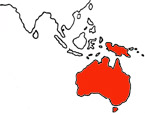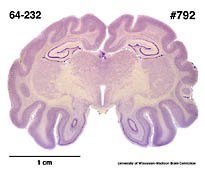Short-beaked
Echidna Tachyglossus aculeatus
The head and body length of T. aculeatus is 350-530 mm, tail
length is about 90 mm, and adult weight is 2.5 - 6 kg. The
body is covered with specialized hairs, or spines, which can
be as long as 60 mm. They are yellow and conceal most of the
body fur which is brown or black. In the Tasmanian subspecies,
however, the spines are mostly covered by the fur. The underparts
are spineless, but covered with thick, bristly fur. The underside
of the short, stubby tail is naked.
The body of T. aculeatus is compressed dorsoventrally,
with a domed back and nearly concave belly. The small head
emerges from the body, seemingly without a neck and the slender
snout is about half as long as the head. It is believed that
the snout is strong enough to crack open hollow logs and dig
through forest litter to unearth ants and termites which are
then caught by the echidna's sticky tongue. All four feet
have five digits and long claws which are well adapted for
digging. T. aculeatus has fairly poor eyesight.
There is a single opening for the passage of urine, feces,
and reproduction. The male has testes which are internal and
the female only develops an abdominal pocket for the incubation
of a single egg during breeding season. The height of the
breeding season is July and August throughout the entire range
of T. aculeatus. The gestation period is brief, lasting from
9-27 days. There is a single, large yolked egg with a leatherlike
shell. This is deposited into the pouch directly from the
cloaca. During the incubation period, embryogenesis occurs
for 10-11 days. At birth, the baby breaks through the flexible
shell of the egg with the help of an egg tooth. At 55 days
old, the young is expelled from the pouch. It is left in a
chosen spot while the mother hunts for food, then returns
periodically to suckle her baby. The baby is weaned about
3 months after leaving the pouch.
T. aculeatus is found in a variety of habitats including rocky
areas, forests, hilly tracts and sandy plains. Borrows and
rock crevices provide shelter where the echidna stays until
late afternoon or night. Temperatures above 32°C cause
the animal to retreat, and severe heat stress occurs at sustained
temperatures of 35°C or above. T. aculeatus will dig deeper
into its burrow when disturbed, but of the ground proves to
hard for digging, the echidna curls its entire body into a
spiny ball. As long as there is a sufficient food source,
T. aculeatus will not go into a torpid state. Torpor is more
a result of a lack of food, primarily ants and termites, than
an effect of temperature.
T. aculeatus is found in S and E New Guinea; Australia,
including Kangaroo Isl (off South Australia) and Tasmania.
![]()



